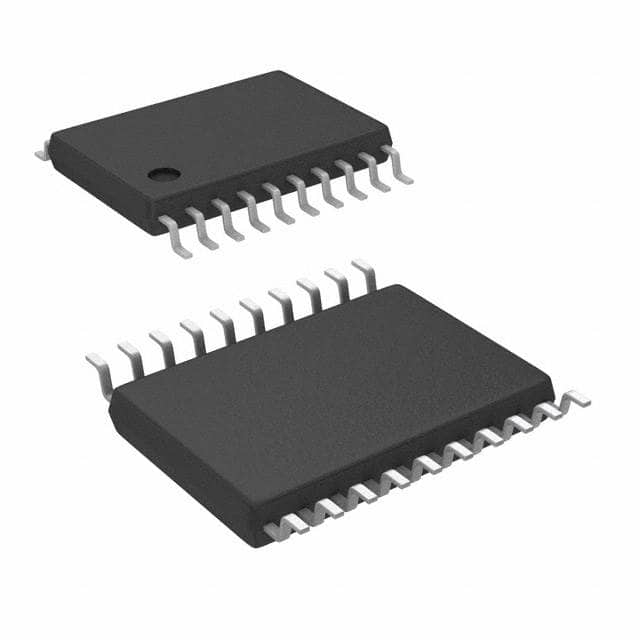Xem thông số kỹ thuật để biết chi tiết sản phẩm.

Encyclopedia Entry: 74ACT240TTR
Product Overview
Category
The 74ACT240TTR belongs to the category of integrated circuits (ICs).
Use
This IC is commonly used in digital electronic systems for signal amplification and buffering purposes.
Characteristics
- The 74ACT240TTR is a high-speed octal buffer/line driver with three-state outputs.
- It operates on a wide voltage range, typically between 4.5V and 5.5V.
- This IC offers fast propagation delay times, making it suitable for high-performance applications.
- It has a low power consumption, making it energy-efficient.
Package
The 74ACT240TTR is available in a small-outline transistor (SOT) package.
Essence
The essence of the 74ACT240TTR lies in its ability to amplify and buffer digital signals effectively.
Packaging/Quantity
This IC is typically packaged in reels or tubes, containing a specific quantity per package. Please refer to the manufacturer's specifications for detailed packaging information.
Specifications
- Supply Voltage Range: 4.5V to 5.5V
- Input Voltage Range: 0V to VCC
- Output Voltage Range: 0V to VCC
- Operating Temperature Range: -40°C to +85°C
- Maximum Propagation Delay Time: 6 ns
- Maximum Quiescent Current: 8 mA
Detailed Pin Configuration
The 74ACT240TTR has a total of 20 pins, which are assigned specific functions as follows:
- Pin 1: Output Y1
- Pin 2: Output Y2
- Pin 3: Output Y3
- Pin 4: Output Y4
- Pin 5: Output Y5
- Pin 6: Output Y6
- Pin 7: Output Y7
- Pin 8: Output Y8
- Pin 9: GND (Ground)
- Pin 10: Input OE (Output Enable)
- Pin 11: Input A1
- Pin 12: Input A2
- Pin 13: Input A3
- Pin 14: Input A4
- Pin 15: Input A5
- Pin 16: Input A6
- Pin 17: Input A7
- Pin 18: Input A8
- Pin 19: VCC (Supply Voltage)
- Pin 20: NC (No Connection)
Functional Features
- The 74ACT240TTR acts as a buffer and line driver, providing signal amplification and buffering capabilities.
- It features three-state outputs, allowing for easy control of the output signals.
- This IC has a high-speed operation, making it suitable for applications requiring fast signal propagation.
Advantages and Disadvantages
Advantages
- Wide voltage range allows for compatibility with various digital systems.
- Low power consumption makes it energy-efficient.
- High-speed operation enables use in high-performance applications.
Disadvantages
- Limited pin count may restrict its use in complex systems requiring more inputs/outputs.
- Availability and pricing may vary depending on the supplier and market conditions.
Working Principles
The 74ACT240TTR works by receiving input signals through its eight input pins (A1 to A8). These signals are then amplified and buffered before being transmitted to the corresponding output pins (Y1 to Y8). The Output Enable (OE) pin controls the activation of the outputs. When the OE pin is low, the outputs are enabled, allowing the amplified signals to pass through. Conversely, when the OE pin is high, the outputs are disabled, resulting in a high-impedance state.
Detailed Application Field Plans
The 74ACT240TTR finds applications in various digital electronic systems, including but not limited to: - Microcontrollers and microprocessors - Data communication systems - Memory interfaces - Industrial automation systems - Automotive electronics
Detailed and Complete Alternative Models
Some alternative models that offer similar functionality to the 74ACT240TTR include: - 74HC240: This IC operates at a lower voltage range (2V to 6V) and has a higher propagation delay time compared to the 74ACT240TTR. - SN74LS240: This IC operates at a wider temperature range (-55°C to +125°C) and has a slower maximum propagation delay time compared to the 74ACT240TTR.
Please note that the suitability of alternative models may vary depending on specific application requirements. It is recommended to consult the manufacturer's datasheets for detailed specifications and compatibility information.
Word count: 610 words
Liệt kê 10 câu hỏi và câu trả lời thường gặp liên quan đến ứng dụng 74ACT240TTR trong giải pháp kỹ thuật
Sure! Here are 10 common questions and answers related to the application of 74ACT240TTR in technical solutions:
Q: What is the 74ACT240TTR? A: The 74ACT240TTR is a octal buffer/line driver with 3-state outputs, commonly used in digital logic circuits.
Q: What is the maximum operating voltage for the 74ACT240TTR? A: The maximum operating voltage for the 74ACT240TTR is typically 5.5V.
Q: How many inputs and outputs does the 74ACT240TTR have? A: The 74ACT240TTR has 8 inputs and 8 outputs.
Q: Can the 74ACT240TTR be used as a level shifter? A: Yes, the 74ACT240TTR can be used as a level shifter to convert signals between different voltage levels.
Q: What is the purpose of the 3-state outputs in the 74ACT240TTR? A: The 3-state outputs allow multiple devices to share a common bus without interfering with each other.
Q: What is the maximum output current that the 74ACT240TTR can drive? A: The 74ACT240TTR can typically drive up to 24mA of output current.
Q: Can the 74ACT240TTR be used in high-speed applications? A: Yes, the 74ACT240TTR is designed for high-speed operation and can be used in applications with fast switching requirements.
Q: Does the 74ACT240TTR have built-in protection against electrostatic discharge (ESD)? A: Yes, the 74ACT240TTR typically has built-in ESD protection to safeguard against damage from static electricity.
Q: Can the 74ACT240TTR be used in both digital and analog circuits? A: No, the 74ACT240TTR is specifically designed for digital logic applications and may not perform optimally in analog circuits.
Q: Are there any specific precautions to consider when using the 74ACT240TTR? A: It is important to ensure proper power supply decoupling and avoid exceeding the maximum voltage and current ratings specified in the datasheet.
Please note that the answers provided here are general and may vary depending on the specific application and requirements. Always refer to the datasheet and consult with a technical expert for accurate information.

